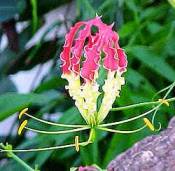

This article highlights a few plants native to the Seychelles,
and natural materials which can be derived from them; more are intended to be
progressively added to this article as time goes by! Thanks to Patrick and
Silvana Bisogni at Islands Scents Ltd., Mahe Victoria, for the opportunity to
visit.
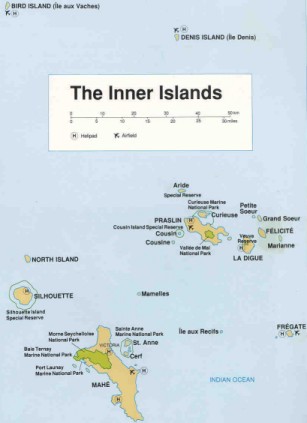 The
Seychelles are a group of some 115 granite & coral islands and atolls, which
lie over 900 Km to the north of Madagascar in the Indian Ocean, and which are
situated from latitude 3º 43' to 10º 8' South and longtitude 46°
10', 56°
20 East . The largest of the islands is Mahé which is some 650 Km from the
coast of Tanzania, directly to the west of the islands. Many islands in this
group are uninhabited, and most tourists head for the mountainous Mahé, and the
adjoining (flatter) islands of Pralin and La Dige. The climate on Mahé is
relatively dependable, the wetter months of the year occurring from November to
March or April, and the sunnier drier months occurring from May to
October/November.
The
Seychelles are a group of some 115 granite & coral islands and atolls, which
lie over 900 Km to the north of Madagascar in the Indian Ocean, and which are
situated from latitude 3º 43' to 10º 8' South and longtitude 46°
10', 56°
20 East . The largest of the islands is Mahé which is some 650 Km from the
coast of Tanzania, directly to the west of the islands. Many islands in this
group are uninhabited, and most tourists head for the mountainous Mahé, and the
adjoining (flatter) islands of Pralin and La Dige. The climate on Mahé is
relatively dependable, the wetter months of the year occurring from November to
March or April, and the sunnier drier months occurring from May to
October/November.
With
relatively constant high humidity and temperatures which rarely drop below 25°C,
and are often in the 30-31°C
region, plants tend to flourish and grow quickly in this region. Mangrove
forests are on the retreat in the Seychelles: settlement has not only reduced
the extent of these valuable items, but also introduced many new foreign plant
invaders to the islands! However, sadly, the overall picture in the Seychelles
over the last several centuries is one of overall decline in the total number of
species found.
Vegetation on many islands can be divided into the littoral (swampy) zones
/mangrove areas, woodland up to 300m. comprising larger trees, woodland up to
600m. comprising smaller trees, and bushes and low trees above 600m. Much of the
island of Mahe has been taken over by introduced cinnamon trees, which have
displaced other native vegetation, but other trees (coffee, wild pineapple, tea
bushes) have also caused nuisance.
In former times, the Seychelles had a reputation for trading in good quality Ambrette seed, Patchouli oil, Vanilla beans, Cinnamon leaf oil and many other raw materials. Competition from other countries, coupled with the inability or lack of intent in controlling crop diseases caused a decline, or a complete cessation in production of many of these items. Many fragrant species abound however: Eucalyptus citriodora, Calophyllum inophyllum, Lantana camara, Ginger lily Hedychium coronarium, Wild Ginger Zingiber zerumbert, Cardamon Elettaria cardamomum, Frangipanis Plumera rubra, P. obtusa etc to name but a few.
This article highlights a few plants native to the Seychelles, and natural materials which can be derived from them; more are intended to be progressively added to this article as time goes by!
![]() 1.
Plectranthus aromatica Roxb.
1.
Plectranthus aromatica Roxb.
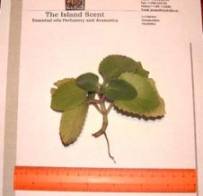 Plectranthus
aromatica,
usually described as native to Indonesia, but found flourishing in the
Seychelles, is a hairy herb with small white flowers and ovate and green
somewhat fleshy serrated leaves, which are strongly and pleasantly aromatic. It
grows on waste ground and shady wooded areas, especially in rocky places, and
may be seen entirely covering many larger granite boulders. A detailed
morphological description can be found in Francis Friedmann’s Flore
des Seychelles – Dicotylédons Éditions
de l’Orstom Paris 1994. In the Seychelles an infusion of the leaves (often
with honey) is used medicinally for treating coughs & colds, but leaves can
also rubbed vigorously between the hands and the vapours from the leaves
inhaled vigorously to clear obstructed nasal passages. According
to Plarm, the indicated uses for this herb are as an expectorant, for the
treatment of brochitis, eczema, fever and rheumatism. (ref:
Medicinal Plants of the Seychelles Series Two pub. National Heritage Printed
by Printec Press Holdings). It should be said that with little currency
available for prescription medicines, many islanders are totally reliant on
local herbs and plants for the treatment of their ailments.
Plectranthus
aromatica,
usually described as native to Indonesia, but found flourishing in the
Seychelles, is a hairy herb with small white flowers and ovate and green
somewhat fleshy serrated leaves, which are strongly and pleasantly aromatic. It
grows on waste ground and shady wooded areas, especially in rocky places, and
may be seen entirely covering many larger granite boulders. A detailed
morphological description can be found in Francis Friedmann’s Flore
des Seychelles – Dicotylédons Éditions
de l’Orstom Paris 1994. In the Seychelles an infusion of the leaves (often
with honey) is used medicinally for treating coughs & colds, but leaves can
also rubbed vigorously between the hands and the vapours from the leaves
inhaled vigorously to clear obstructed nasal passages. According
to Plarm, the indicated uses for this herb are as an expectorant, for the
treatment of brochitis, eczema, fever and rheumatism. (ref:
Medicinal Plants of the Seychelles Series Two pub. National Heritage Printed
by Printec Press Holdings). It should be said that with little currency
available for prescription medicines, many islanders are totally reliant on
local herbs and plants for the treatment of their ailments.
There is some confusion about the exact botanical identification; Plarm gives P. aromaticus as syn. Coleus amboinicus Lour., ; many works name Coleus amboinicus as Indian Borage, and J.W. Pursglove (1968) gives the uses of the aromatic leaves as stuffing and flavouring meats in S.E.Asia & W. Indies. Pursglove also indicates C. amboinicus as syn. C. aromaticus.
Plectranthus L’Hérit is a subdivision of the Labiatae genus which constitutes some 200 tropical and Old World shrubs including Coleus & Solestemon (ref: D.J. Mabberley 1998), many of which have local therapeutic uses. A number of studies have been carried out on the composition of essential oils of various Plectranthus spp. including P. frutescens which was found to contain 60% carvacrol (Bos R. et al. 1983 “The composition of the essential oil in the leaves of C. aromaticus Bentham and their importance as a component of the species Antiaphthosea.” Ref: Pharm. Weekbl. Ned. Sci. Ed. 5:129).
To further complicate the situation there appear to be two differing forms of P. aromaticus on Mahe: a small leafed form and a large leafed form, which yield essential oils differing in odour and composition (unpublished information). The exact botanical status of these forms is not clear, but is not thought to have any connection with plant maturity. This situation is currently under investigation.
An analysis of the essential oil of P. amboinicus is given in Plantes Medicinales du Maurice Vol 2. by Ameenah Gurib-Fakim ISBN 99903-0-203-0 p 191, which gives the following information for the Seychelles oil: para-cyminene (alpha-para-dimethyl styrene) 45.7% para-cymene 11.8%, carvacrol 9.9%; gamma-terpinene 9.3%, alpha-terpinene 4.6%, limonene 3.6% and b-caryophyllene 2.7% (this figures are accredited to Murugaiyan et al. 1993, but no further details are to be found). A locally produced, water-distilled essential oil prepared from fresh leaves collected in December/January was found to be clear orange coloured oil very medicinal, phenolic odour with a hint of cinnamon-spice, becoming more reminiscent of the odour of the Wrights Coal Tar Soap after 5 minutes. The dry-out on a perfumers strip is warm, spicy cinnamon-like, the phenolic note being slightly thyme-like, blended with an aldehydic orange note.
 M.L.
Villate et al. (1999) working on the isolated ileum of guinea pigs and deferent
ductus of rats found anti-muscarinic and adrenergic effects for the aqueous
extract and commented on possible anti-epileptic action and potential
anti-depressant activity. Toxicological references include dose-dependent
cyto-toxic and genotoxic effects of the fluid extract and essential oil
of P. amboinicus, which
were highlighted in a paper by A.V. Parra et al. who worked on a
genotoxic trial system involving a somatic segregation test in diploid D-30 Aspergillus
nidulans.
M.L.
Villate et al. (1999) working on the isolated ileum of guinea pigs and deferent
ductus of rats found anti-muscarinic and adrenergic effects for the aqueous
extract and commented on possible anti-epileptic action and potential
anti-depressant activity. Toxicological references include dose-dependent
cyto-toxic and genotoxic effects of the fluid extract and essential oil
of P. amboinicus, which
were highlighted in a paper by A.V. Parra et al. who worked on a
genotoxic trial system involving a somatic segregation test in diploid D-30 Aspergillus
nidulans.
References
A.V. Parra et al. (1999) Plectranthus
amboinicus (Lour.) Spreng. (Orégano Francés): “Estudio toxicogenetico de
un extracto fluido y del aceite esencial.” Rev
Cubana Plant Med 3(2) 68-73.
Plarm: Plantes Aromatiques et medicinales de l’Ocean Indian. Commission de l’Ocean Indien – Union Euopreenne.
Pursglove JW (1968) “Tropical crops: Dicotyledons” pub. Longman.
M.L. Villate et al. (1999) Plectranthus amboinicus (Lour.) Spreng. (Orégano Francés): Effecto Antimuscarino y potenciación de la adrenilina. Rev Cubana Plant Med 1(4), 29-32.
![]() Vitex
trifolia L.
Vitex
trifolia L.
Vitex trifolia is an aromatic shubby tree which can grow to 4m. in the Seychelles, bearing trifoliate leaves, or more rarely 1-2 leaves. Its distribution includes tropical Asia up to S. China, and down to N. Australia.
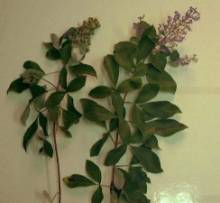 Oil
distilled from the leaves of Seychelles trees according to Murugaiyan et al
(1993)
was
composed of the following components: 1,8-cineole 23.5%, sabinene 20.8%, alpha-pinene
14.2%, ß-pinene
, alpha-terpinyl acetate 5.7%, ßeta-caryophyllene
5.7%. Further reviews of the essential oil of Vitex
trifolia from various locations have appeared, by A. Suksamrarn et al
(1991). In this latter publication attention is drawn to the finding of his
earlier work that (A. Sukksamrarn (1990)), that
ß-caryophyllene
is the most common sesquiterpene in Vitex
spp., and that the concentration of beta-caryophyllene
varies inversely with the concentration of 1,8-cineole. Farn JI et al (1981) had
previously remarked that the Chinese oil from Vitex
trifolia shows similarities to Vitex
negundo var. cannabifolia with alpha-pinene
as the main component. The team were particularly interested in any possible
hormonal effects associated with the oil, as is the case with the related Vitex
agnus-castus.
Oil
distilled from the leaves of Seychelles trees according to Murugaiyan et al
(1993)
was
composed of the following components: 1,8-cineole 23.5%, sabinene 20.8%, alpha-pinene
14.2%, ß-pinene
, alpha-terpinyl acetate 5.7%, ßeta-caryophyllene
5.7%. Further reviews of the essential oil of Vitex
trifolia from various locations have appeared, by A. Suksamrarn et al
(1991). In this latter publication attention is drawn to the finding of his
earlier work that (A. Sukksamrarn (1990)), that
ß-caryophyllene
is the most common sesquiterpene in Vitex
spp., and that the concentration of beta-caryophyllene
varies inversely with the concentration of 1,8-cineole. Farn JI et al (1981) had
previously remarked that the Chinese oil from Vitex
trifolia shows similarities to Vitex
negundo var. cannabifolia with alpha-pinene
as the main component. The team were particularly interested in any possible
hormonal effects associated with the oil, as is the case with the related Vitex
agnus-castus.
A water-distilled oil was obtained in low yield from the partially dried leaves, collected on Mahe in March, after 14 hours distillation. It was seen as a yellow oil with very powerful odour, bitter blackcurrant, piney and cineolic. One or two drops on a strip were so powerfully blackcurrant-catty that in a domestic situation it was found to be very unpleasant.The dry out is very persistent on a perfumers strip, with a strong woody note still evident at 2-3 weeks.
Work is continuing looking at the composition and properties of the fruit and leaf oils, which appear different.
References:
Farn JI et al (1981) “Studies on the chemical constituents of Chinese Vitex I. Chemical constituents of essential oils of certain Vitex spp.” Chin Trad. Herb. Drug 12, 393-396.
Suksamrarn A. et al. (1991) “Variation of Essential Oil Constituents in Vitex trifolia species” Flav. & Fragr. J. 8, 97-99.
Suksamrarn A. et al. (1990) Flav. & Frag. J. 5, 53.![]() Rothmannia
annae (Wright) Keay (syn. Gardenia
annae) – Wrights gardenia.
Rothmannia
annae (Wright) Keay (syn. Gardenia
annae) – Wrights gardenia.
 Gardenia
species are known to be naturalised in the Seychelles, including Gardenia
augusta (L.) Merill (syn. G. florida L.;
G. jasmoides Ellis ) “Rose conde”,
but this species was not found by the authors team on Mahe. Wrights gardenia Rothmannia
annae or “Bois citron” as it
is known locally, is cultivated as an ornamental in some gardens on Mahe, but is
more especially associated with the island of Aride, a privately owned island
accessible by powerboat from Mahe. If any flower is to be considered as a
candidate for the national flower of the Seychelles, it should be this one in
the author’s opinion! The flowers of the Wrights gardenia tree appear to have
two different petal colourings on Mahe, one type of pure white, and white
mottled with pink, although on Aride only the mottled flowers were found. The
blossoms have an indolic impression, reminding somewhat of Tuberose and
Carnation, but not so medicinal and less heady. The flowers attract bees which
appear to become drunk on the flower nectar. Before thinking of smelling a
particular blossom it is therefore fairly important to see whether the petals
are enveloping a stupefied bee!
Gardenia
species are known to be naturalised in the Seychelles, including Gardenia
augusta (L.) Merill (syn. G. florida L.;
G. jasmoides Ellis ) “Rose conde”,
but this species was not found by the authors team on Mahe. Wrights gardenia Rothmannia
annae or “Bois citron” as it
is known locally, is cultivated as an ornamental in some gardens on Mahe, but is
more especially associated with the island of Aride, a privately owned island
accessible by powerboat from Mahe. If any flower is to be considered as a
candidate for the national flower of the Seychelles, it should be this one in
the author’s opinion! The flowers of the Wrights gardenia tree appear to have
two different petal colourings on Mahe, one type of pure white, and white
mottled with pink, although on Aride only the mottled flowers were found. The
blossoms have an indolic impression, reminding somewhat of Tuberose and
Carnation, but not so medicinal and less heady. The flowers attract bees which
appear to become drunk on the flower nectar. Before thinking of smelling a
particular blossom it is therefore fairly important to see whether the petals
are enveloping a stupefied bee!
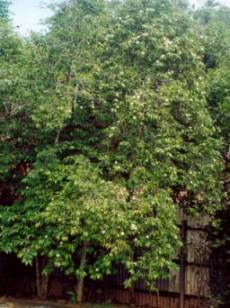 Gardenia
has never been an important raw material in extrait perfumery, although the
gardenia note is an important feature of such famous perfumes as Ma Griffe
(Carven1946) and more recently Envy (1996 Gucci). Geranium was at one time
cultivated in Reunion, and yield of the floral concrete from Gardenia
jasminoides flowers has been quoted as 0.016%. Chinese & Haitian
gardenia absolute samples have been evaluated by the author
(in Natural Odour Materials-Odours
& Origins by Tony Burfield pub. Atlantic Institute of Aromatherapy,
Tampa 2000) but found to be poor olfactory products, with a dominant burnt
caramelic note. Gardenia flowers macerated in Coconut oil, thus retaining the
scent, is a commercial export item from Tahiti.
Gardenia
has never been an important raw material in extrait perfumery, although the
gardenia note is an important feature of such famous perfumes as Ma Griffe
(Carven1946) and more recently Envy (1996 Gucci). Geranium was at one time
cultivated in Reunion, and yield of the floral concrete from Gardenia
jasminoides flowers has been quoted as 0.016%. Chinese & Haitian
gardenia absolute samples have been evaluated by the author
(in Natural Odour Materials-Odours
& Origins by Tony Burfield pub. Atlantic Institute of Aromatherapy,
Tampa 2000) but found to be poor olfactory products, with a dominant burnt
caramelic note. Gardenia flowers macerated in Coconut oil, thus retaining the
scent, is a commercial export item from Tahiti.
Gathering the Wright’s gardenia blossoms at dusk, extracting immediately with hexane, and carefully removing the solvent, a yellow somewhat grainy wax-like solid was obtained which had a green leafy top note overlying a rich honeyed floral background which has some Carnation-like aspect odour. The concrete loses completely any indolic character of the blossoms, but retains the floral sweetness. Analysis of the concrete is being carried out to find out more about the composition of the floral scent.
Copyright © 2001 by Tony Burfield. All Rights Reserved.